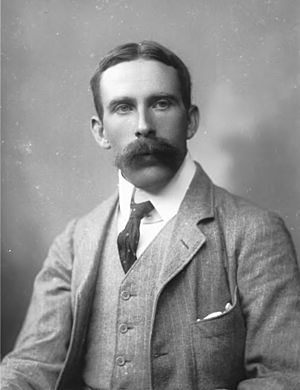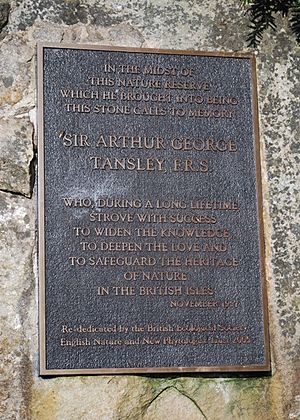Arthur Tansley facts for kids
Quick facts for kids
Sir Arthur Tansley
|
|
|---|---|

Arthur Tansley in the 1890s
|
|
| Born |
Arthur George Tansley
15 August 1871 London, England
|
| Died | 25 November 1955 (aged 84) Grantchester, England
|
| Known for | New Phytologist, British Ecological Society, Ecosystem concept |
| Spouse(s) | Edith, Lady Tansley (née Chick) |
| Awards | Linnean Medal (1941) Fellow of the Royal Society |
| Scientific career | |
| Notable students | Alexander Watt |
| Influences | Eugenius Warming |
Sir Arthur George Tansley was an English botanist (someone who studies plants). He was a very important scientist who helped create the study of ecology. Ecology is the science of how living things interact with each other and their environment.
Arthur Tansley went to Highgate School, University College London, and Trinity College, Cambridge. He later taught at these universities and at Oxford. He was a professor of botany until he retired in 1937. In 1902, Tansley started a science journal called New Phytologist. He was its editor for almost 30 years. He was a leader in the science of ecology in Britain. He was inspired by a Danish botanist named Eugenius Warming. Tansley also came up with the important idea of the ecosystem in biology. He helped start the first group for ecologists, which later became the British Ecological Society. He was its first president and helped start its journal, Journal of Ecology. Tansley also led the British Nature Conservancy, which works to protect nature. He became a Fellow of the Royal Society in 1915 and was made a knight in 1950. Today, a medal and special reviews are named after him.
Contents
Who Was Arthur Tansley?
Early Life and Learning
Arthur Tansley was born in London in 1871. His father, George Tansley, was a businessman who loved education. George Tansley even became a volunteer teacher. Arthur's interest in science began when he met one of his father's friends. This friend was a great botanist who loved studying plants outdoors.
Arthur went to Highgate School when he was 12. He didn't like the science teaching there, so he moved to University College London in 1889. There, he studied biological science. He was greatly influenced by his teachers, Ray Lankester and F. W. Oliver. In 1890, Tansley went to Trinity College, Cambridge. After finishing his studies in 1893, he worked as an assistant to Professor Oliver. He finished his degree in 1894 with top honors.
A Career in Science
Tansley taught and did research at University College London from 1893 to 1907. In 1907, he became a lecturer at the University of Cambridge. During the First World War, he worked for the government. In 1923, he left Cambridge and spent a year in Vienna. There, he studied psychology, which is the study of the mind.
When he came back to Britain in 1924, Tansley led a committee about plant life in the British Empire. After four years away from teaching botany, he became a professor at the University of Oxford in 1927. He stayed there until he retired in 1937.
Big Ideas and Discoveries
Starting a Science Journal
Tansley's early work was about palaeobotany, which is the study of ancient plants. In 1902, he started the botany journal New Phytologist. He wanted it to be a place where British botanists could easily share ideas. He also wanted it to publish "notes and suggestions," not just finished research. He was the editor of this journal until 1931.
Understanding Plant Life
Tansley became interested in ecology in 1898. He read a book by a Danish botanist named Eugenius Warming. This book made him want to go outside and see how plants grew together in England. In 1904, Tansley suggested creating a group to study and map plants in Britain. This led to the creation of the British Vegetation Committee. Tansley was a leader of this group. Their goal was to work together and use the same methods to study plants.
In 1911, Tansley helped organize the first International Phytogeographic Excursion (IPE). This was a trip where botanists from different countries could study plants together. He had been inspired by a similar trip in Switzerland. These trips helped connect British and American plant ecologists. Tansley wrote a book called Types of British Vegetation for the first IPE.
The "Ecosystem" Idea
In 1913, the British Vegetation Committee started the British Ecological Society (BES). This was the first professional group for ecologists ever. Tansley was its first president. He also became the first editor of the Journal of Ecology, a job he held for 21 years.
One of Tansley's most important ideas came in 1935. He wrote about the "ecosystem concept." Before this, some scientists thought of groups of plants and animals as single, giant organisms. Tansley disagreed. He said that we can't separate living things from their surroundings. He explained that organisms and their environment work together as one physical system. He wanted people to see how materials and energy move between living things and their environment. He believed that ecosystems are the basic units of nature.
Tansley also wrote several books to help teach about plant ecology. These included Elements of Plant Ecology (1922) and Practical Plant Ecology (1923). His most complete work, The British Islands and Their Vegetation, was published in 1939. He received the Linnean Medal in 1941 for this great achievement.
Protecting Nature
During the Second World War, Tansley became very interested in protecting nature. After the war, he led a committee that created a plan for nature reserves. This led to the creation of the Nature Conservancy, which he also led. Tansley was made a knight in 1950 because of his important work in conservation.
Exploring the Mind
Tansley also became interested in psychology, the study of the mind. This interest grew after a dream he had during the First World War. In 1920, he wrote a book called The New Psychology and its Relation to Life. This book helped introduce the ideas of famous thinkers like Sigmund Freud and Carl Jung to many people. The book was very popular. In 1922, Tansley spent time with Freud. He even moved his family to Vienna for a year to study more. Even though he went back to studying plants, he stayed in touch with Freud. Some researchers believe Tansley's ideas about ecology and psychology were connected.
Family Life

In 1903, Tansley married Edith Chick. She was a former student, and they even wrote two science papers together. They had three daughters named Katharine, Margaret, and Helen. Lady Edith Tansley lived to be 100 years old. Tansley was an atheist.
See Also
- Hugh M. Raup

